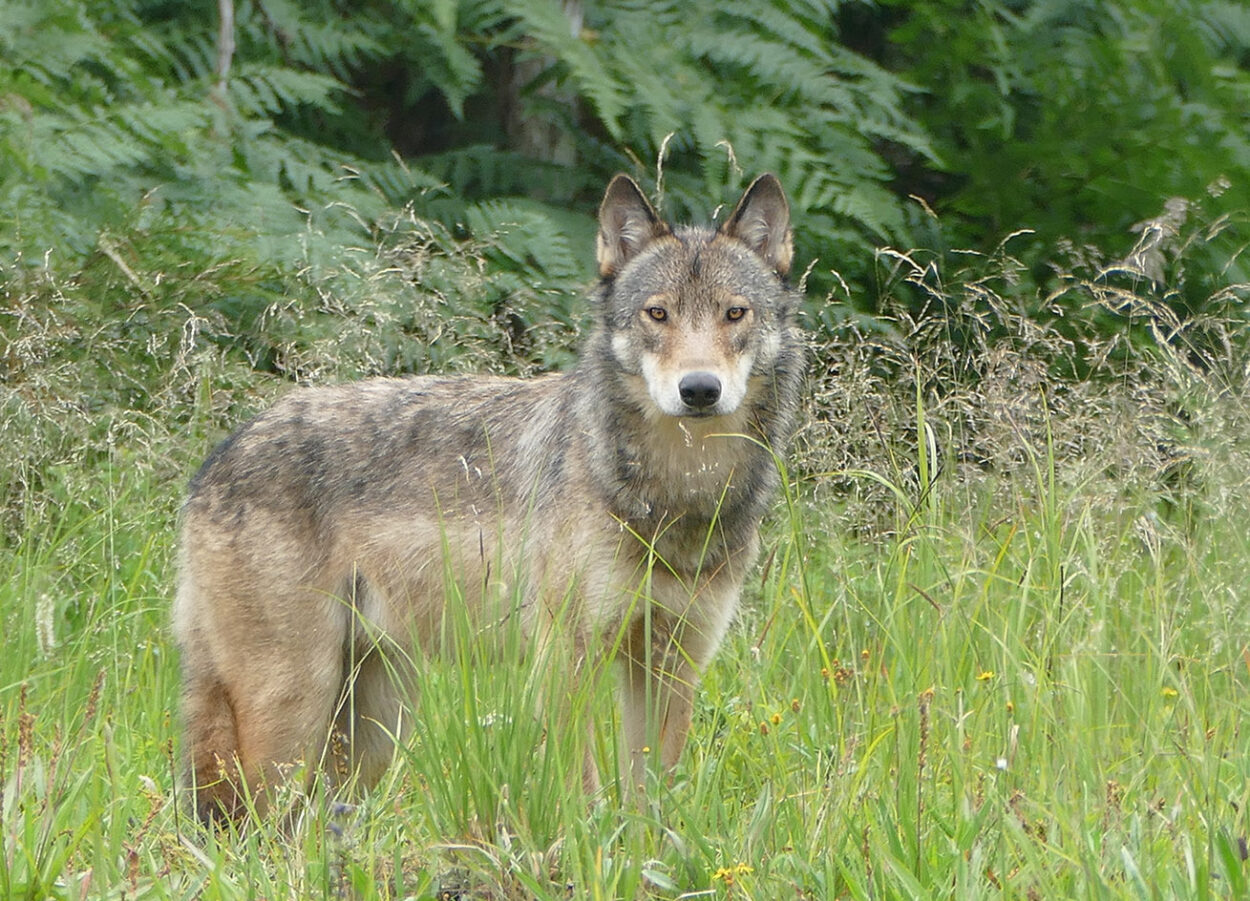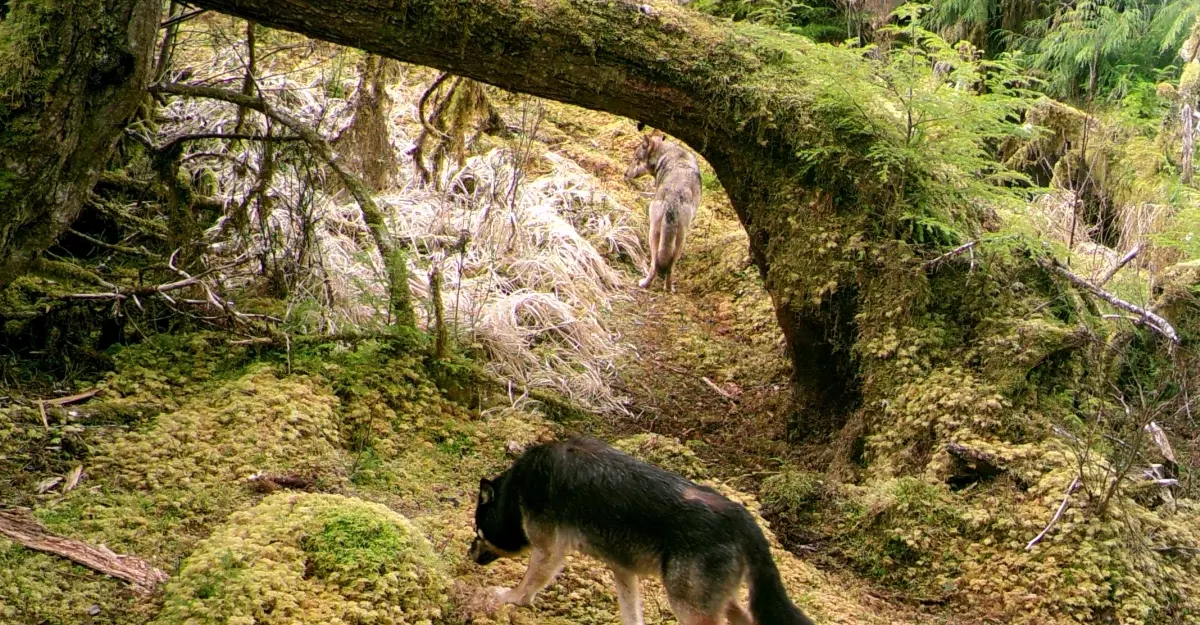
In August, the U.S. Fish and Wildlife Service denied a petition to list the Alexander Archipelago wolf on the endangered species list. It was the third such petition in two decades. Part of this latest review included something new – incorporating local indigenous knowledge about the wolves.
Environmental groups have tried for years to get the wolves listed as endangered. Most recently, in the form of a petition from the Center for Biological Diversity, Alaska Rainforest Defenders, and Defenders of Wildlife. In their review, U.S. Fish and Wildlife had to consider the wolf’s cultural and ecological place in its environment.
The U.S. Fish and Wildlife Service interviewed nine Lingít, Haida, and Tsimshian wolf experts in Southeast Alaska to learn more about the species.
For federal and state agencies, Alexander Archipelago wolf populations are notoriously tricky to estimate.
For biologists, hearing cultural and ecological indigenous knowledge from those that live close to the wolves made a big difference.
“We learned a lot about wolf abundance,” said Sarah Markegard, Ecological Services Program Biologist with USFWS and the project’s lead. “And we even received quantitative information that we were actually able to use in our population models. So that was kind of unexpected and an amazing addition to what we knew.”
At a federal seminar on the wolves, Dr. Stephen Langdon, an anthropologist, called this project nothing short of revolutionary.
“I’d like to thank the indigenous experts, Tim, Mike and Scott, as well as the others that they’re that participated for this really important, and I think, groundbreaking, path-cutting acquisition and utilization of indigenous knowledge going forward. This project followed through on the President’s directive to make use of indigenous knowledge in federal regulatory action and you made that extremely possible. We made a very significant, pathbreaking effort in that regard,” said Langdon.
In a later call, Langdon said this is one of the most robust uses of indigenous knowledge in a federal policy decision that he’s seen. And he said how it was used is especially important.
“They drew on that knowledge and the knowledge was actually quoted, which is in other words, it wasn’t paraphrased. Okay? It was actually brought in on a quote basis, which I think is an important point of emphasis,” Langdon explained.
“It was just quite eye opening to hear all of the information and the engagement over time – it’s also very revealing in terms of the models, the very sophisticated models that the indigenous experts had. And their understanding of these models is guided by the principle of balance. There has to be a balance between the subsistence needs of humans, and those of the wolves and deer population.” According to Langdon, most of the federal and state research on Southeast wolf populations up to this point has been isolated to Prince of Wales Island. They knew very little about the wolves in the northern reaches of the Archipelago. But for local indigenous experts, that wasn’t the case.
The Indigenous science within the report details overlap between Southeastern wolves and their larger, shaggier cousins: the Yukon timberwolves – something that came as a shock to Langdon, Markegard, and the western scientists. In the report, Yukon timberwolves were spotted in the Haines gateway and Yakutat areas and signs of local wolves that had bred with interior timberwolves were seen as far south as Metlakatla.
“All these trails lead up into the Interior, into the Yukon. So, as the animals migrate back and forth, I’m sure the Yukon wolves come down this far and intermingle with southerly packs here. It’s pretty interesting,” Tim Ackerman, a Lingít storyteller and wilderness steward in Haines, explained. He grew up tracking timberwolves across Alaska’s interior. As a lifelong trapper, Ackerman has observed these wolves in their natural habitat for as long as he can remember.
Ackerman said that in the past, local and indigenous knowledge has been discredited in the scientific community. “A lot of the guys that are wolf biologists and stuff like that don’t like to hear people that aren’t per se educated at the college level. Game biologists will think, ‘this guy doesn’t know what he’s talking about because he’s not a biologist. He doesn’t have the college level degree.’ All of that stuff.”
“But it really helps that I come from Alaska and have been here all my life. And I know I see things and observe animals and who’s to say that he can tell me that that wasn’t what I saw? You know, he’s from New York or something and he’s just got this degree.”
Ackerman stressed that wolves are crucial to the health of the deer population and always have been. This animosity towards the wolf? The constant debate about population density? They’re Western problems, he said.
“The perception of the Western society is looking at these animals as a pest, basically. You know, the scary wolf. It’s going to eat all the cows, kill all the cows, kill everything. So, they poison them, trap them, shoot them.”
Southeast wolves organize into packs of roughly a half dozen up to 30 or more depending on the time of year, joining together to form the largest groups in the fall and splitting up for mating season. Packs reunite when the pups are big enough to travel and learn to hunt.
Another revelation biologists heard in the Indigenous knowledge report was that pack sizes get larger as you go north.
“Growing up around wolves, we knew them intimately and they have a part in our lives. Because they kind of controlled us as we do try to control them. They control the bounty of the deer and moose that we have,” said Michael Jackson, a Lingít elder in Kake. As Jackson puts it, humans and wolves are inextricably linked in Southeast Alaska.
One of his distant relatives, Scott Jackson, is a master wolf trapper in Kake. He also contributed to the report. Scott Jackson speaks a bit more gravely of the wolf. He said without trapping to thin the population, wolves decimate the deer population. The same deer that his community relies on for food. Putting the wolf on the endangered species list, he said, could also put his relatives in danger. For Jackson, helping state and federal managers was about striking the right balance.
“So, it was more about helping control the island and helping put it back in a positive manner,” the wolf trapper said of working with management biologists. “So, we didn’t have to put our families and friends lives at risk. And for me, that was more important than anything else. That we try not to lose an uncle, a Hall of Fame coach, nephews, sons. Again.”
Jackson spoke of an event that happened on a very cold New Year’s Day 20 years ago. Wolves had taken a majority of the nearby deer. A group of his relatives and subsistence hunters from the community attempted to ford a dangerous river in pursuit of game to fill their freezers. He says he lost a cousin, a family friend, and a local coach that day.
Last year, the Biden administration released formal guidance on incorporating Indigenous Knowledge into scientific practice to inform federal research, policy and decision-making. Across federal agencies, advocates say it’s an attempt to remedy prior dismissals of this form of knowledge and strengthen the nation-to-nation relationship with tribes.
Wolves are smart. Scott Jackson said if you capture them or put up a bunch of trail-marking tape in an area, they’ll stop going there. We study the wolves to learn how to manage them in their natural habitat. But the act of studying them can affect that habitat.
“We work with biologists, that’s how we maintain the balance. I think leveling on both sides is what I’d like to see. I’d like to see people continue to study, people continue to trap – my friends, myself, my kids. I mean, I can outright say that I don’t want to see them on the endangered species list,” Jackson stated.
He said he hopes the new guidance on acknowledging Indigenous expertise will help shape future policy and that he’d like to continue trapping and teach his sons that there needs to be balance and respect.
CORRECTION: A previous version of this story incorrectly stated that in Lingít and Haida culture, those in the Wolf clans are descendants of the wolf. The Wolf as a crest and identity symbol is derived from ancestral foundational interactions with wolves.






